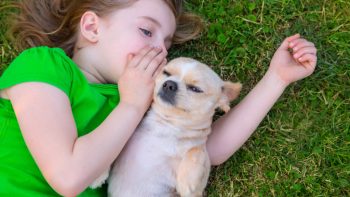
The consensus among scientists and researchers is that having pets in the home does, indeed, promote healthier children.
With certain obvious safety and allergy precautions notwithstanding, pets (particularly cats and dogs) have been found to make for healthier babies and children. Opponents of what some refer to as the “over-sanitization” of baby’s homes often cite this fact. A similar theory involving allergies, the “hygiene” hypothesis, suggests excessive cleanliness of an infant and child’s environment can promote greater risk of developing allergies.
While dirt and certain pathogens are associated with pets in the home, maintaining proper pet hygiene and behavior can address those concerns. The physical and emotional benefits pets bring to a home — and particularly to the young people living there — are enormous. Some of the ways pets have been found to make children healthier are specific to babies, while others benefit children of all ages. Likewise, some of the benefits have been proven for specific pets, like cats or dogs, while other benefits are more general in nature.
Physical Health Benefits of Pets
Pet dander, along with the microbes, bacteria and viruses pets bring in from outside, may help young people’s developing immune systems to prime and protect against common allergens and pathogens.
Related Article: 5 Reasons Your Pet Needs Its Own Room
Pets have also been found to lower blood pressure. A benefit to children with pets in the home is that healthier kids need fewer antibiotics throughout their childhood. Antibiotic overuse is known to promote the production of drug-resistant bacteria more difficult to treat. Having a pet can also benefit kids physically by promoting greater exercise through walking and playing with them.
Mental and Emotional Health Benefits of Pets
In addition to lowering blood pressure, pets have also been found to provide other benefits known to produce better mental and emotional health. Pets can reduce stress, making children more capable and empowered to calmly confront the challenges in their lives.
Pets also promote greater social interactions amongst people. Children who are taught these skills early have the advantage of greater social skills and increased confidence and comfort in group settings.
Studies have even shown pets can increase children’s learning skills. Other developmental and behavioral benefits of children having pets include learning responsibility, which can help kids take better care of themselves. They also learn how to deal with loss when a pet dies.
Benefits Specific to Babies
Research shows pets in the home may help reduce a baby’s risk of developing sniffles or coughs during the first year of life. According to Pediatrics journal, babies raised in a home with a dog or cat get sick less often than babies in pet-free homes. They’re about 30 percent less likely to get a respiratory tract infection or need antibiotics for any reason, and almost 45 percent less likely to get an ear infection than their peers.
Interestingly, those babies whose dogs spent fewer than six hours each day in the home were even healthier than those whose dogs were always indoors. This bolsters the theory that the reason for these benefits is enhanced immune-system development from exposure to dirt, dust and microbes from outside.
Related Article: The Best Pets for a Small Living Space
This research also supports studies finding a link between pets in the home and reduced risk among babies of experiencing allergies. Another series of studies has, so far, only been studied in mice and not yet researched on human subjects. Nevertheless, these studies found homes containing dogs produced exposure to a type of dust that protected the mice against a type of respiratory infection known to pose a higher risk of childhood asthma in humans.
Benefits for All Children
Similar results have been found in children post-infancy, some of which seem to be linked to pet exposure in infancy. For example, a study of Swedish seven to 13-year-olds found a smaller prevalence of asthma and allergic rhinitis in those exposed to pets in their first year of life.
Other studies have found benefits of pets for children post-infancy regardless of whether they had pets in the home during their first year of life. A study in the U.K., for example, found children from five to 11 years of age had fewer sick days than their peers if they lived with pets in the home. Another study found kids raised on farms had a 50 percent lower prevalence of acquiring asthma than other children.
Differences Among Types of Pets
In studies, babies and children brought up in homes with dogs proved even healthier than those brought up with cats. Babies raised with a dog in the home were over 30 percent likelier to remain healthy throughout their first year than those without a dog. Meanwhile, babies in homes with cats were only six percent likelier to stay healthy their first year over those in households without cats.
Other pets like fish, reptiles and indoor-only birds may not provide the immune-enhancing benefits of cats, dogs and birds that do spend part of their time outside, but they still provide other health benefits.
Precautions and Exceptions
Obviously, you still need to keep your pet and its feeding and sleeping areas clean, as well as clean up after your pet when it comes back indoors from outside.
Beyond that, there are certain other precautions to take and exceptions to be aware of. If your child is already predisposed to allergies or asthma, for example, then bringing a pet into the home could only exacerbate the problem.
Additionally, the studies finding benefits in the elements a pet tracks in from outdoors have tested mostly in rural and suburban environments. If you live in an urban setting, there may be cause for greater concern about what your pet is carrying in from outdoors and whether it may be harmful instead of beneficial.
Related Article: 12 House Plants That Are Toxic to Pets
By Admin –



